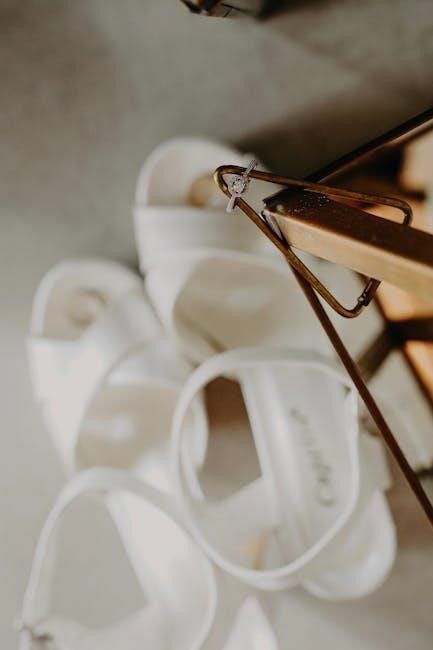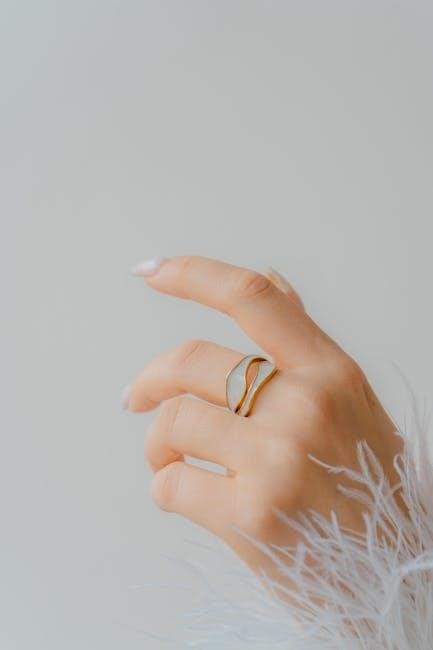An essential ring size guide for ladies, providing a clear understanding of how to determine the perfect fit. This guide offers practical advice, ensuring accurate measurements and a comfortable wear. Ideal for both personal use and gift-giving, it covers various sizing methods and factors influencing ring fit.
How Ring Sizes Work
Ring sizes are numerical, based on finger circumference in millimeters. Standard ladies’ sizes range from 3 to 9, with half sizes available for precise fit, each increasing by 0.4mm.
Understanding Numerical and Alphabetical Sizing Systems
In the US, ring sizes are numerical, ranging from 3 to 13.5, with increments of 0;4mm per half size. For ladies, sizes typically range from 3 to 9. The UK uses alphabetical sizing, such as H, I, or J, corresponding to specific diameters. Each system ensures a consistent fit, with numerical sizes based on finger circumference measurements and alphabetical sizes reflecting inside diameters. Understanding these systems helps in selecting the correct size, especially when shopping across international brands or converting between US and UK standards.
US vs. UK Ring Size Charts: Key Differences
The US and UK ring size systems differ significantly. In the US, sizes are numerical, ranging from 3 to 13.5, with increments of 0.4mm per half size. The UK uses alphabetical sizing, from A to Z, based on inside diameters. A key difference is that the same numerical size in the US corresponds to a larger ring than its UK alphabetical equivalent. For example, a US size 6 is larger than a UK size L. This variation stems from differing measurement standards, making it essential to consult conversion charts when shopping internationally to ensure the correct fit.

Measuring Your Ring Size at Home
Easily determine your ring size using a string, paper strip, or tape measure. Wrap it snugly around your finger, mark the overlap, and compare to a size chart for accuracy.
Using a String or Paper Strip Method
To measure your ring size at home, use a flexible string or paper strip. Wrap it snugly around your finger, ensuring it slides over the knuckle. Mark the point where the ends overlap, then lay it flat to measure the length with a ruler. Compare this measurement to a standard ring size chart to find your size. For accuracy, ensure the paper is printed at 100% scale. This method is simple and effective for determining your perfect fit without specialized tools.

How to Use a Tape Measure for Accurate Fit
For precise measurement, wrap a flexible tape measure around the base of your finger. Ensure it is snug but not too tight, as this can cause discomfort. The tape should slide easily over the knuckle. Measure the circumference in millimeters and compare it to a standard ring size chart. For the best fit, measure at the end of the day, as fingers can swell slightly. This method provides a reliable way to determine your size accurately and comfortably.

Factors That Influence Ring Size
Finger shape and knuckle size significantly impact ring fit. Temperature changes and weight fluctuations can also cause variations, affecting the perfect fit. Consider these factors for optimal comfort.
The Impact of Finger Shape and Knuckle Size
Finger shape and knuckle size play a crucial role in determining the perfect ring size. Slender fingers may require a smaller size, while wider fingers or larger knuckles might need a slightly bigger size for comfort. The knuckle size is especially important, as the ring must fit comfortably over it without feeling too tight or slipping off. Measuring the finger at its widest point ensures a proper fit, considering both the finger’s shape and knuckle size for optimal comfort and aesthetics.
How Temperature and Time of Day Affect Fit
Temperature and time of day significantly influence ring fit. Fingers tend to swell in warmer climates or during the afternoon, while they shrink in colder conditions or in the morning. This natural fluctuation can affect how a ring feels throughout the day. For accurate sizing, measure your finger at room temperature and avoid sizing after extreme temperature changes. Consider the time of day, as fingers are usually largest in the late afternoon. These factors ensure a comfortable and secure fit for your ring.
International Ring Size Comparisons
Ring sizes vary globally due to different measurement standards. US, UK, and European sizes differ, with conversions needed for accuracy. Always check international charts to ensure the perfect fit.
Converting US Sizes to UK and European Standards
Converting ring sizes between US, UK, and European standards requires careful attention to measurement differences. US sizes are numerical, while UK sizes use letters, and European sizes are often based on diameter in millimeters. To convert, compare the internal diameter of the ring in millimeters to the corresponding size in each system. For example, a US size 6 (16mm) is equivalent to a UK size L and a European size 52. Using a conversion chart or a professional ring sizer ensures accuracy. Always double-check measurements for a perfect fit.
Determining Your Finger Size
Accurately measuring your finger is crucial for the perfect fit. The average women’s ring size ranges from 5 to 7, with size 6 being the most common. Consider finger shape and knuckle size, as they can affect the fit. Measure at room temperature for consistency, ensuring the ring slides comfortably over the knuckle. Use a ring size chart or professional tools for precise measurement.
Average Women’s Ring Sizes and Popular Fits
The average women’s ring size typically falls between 5 and 7, with size 6 being the most common. Popular fits vary slightly, but sizes 5-7 are consistently preferred for comfort and style. Thicker bands may require a larger size, while delicate designs often fit true to size. Finger shape and knuckle size also influence fit, with longer fingers tending to accommodate larger rings. Measuring at room temperature ensures accuracy, as fingers can swell or shrink slightly throughout the day. Understanding these factors helps in selecting a ring that balances aesthetics and comfort perfectly.
Printable Ring Size Charts
Download and print a standard ring size chart to easily determine your size at home. Ensure the chart is printed at 100% scale for accuracy. Compare your ring to the circles to find the best fit, helping you choose the perfect size effortlessly.
How to Use a Printable Chart for Accuracy
To ensure precision, print the ring size chart on standard paper at 100% scale. Place a ruler next to it to verify the measurements. Slide your ring over the printed circles until it fits snugly within one. This method ensures the ring is neither too tight nor too loose. For the best results, measure at room temperature, as fingers can swell slightly during the day. If unsure, consider consulting a professional jeweler for an accurate fit.

Tools for Measuring Ring Size
Common tools include a ring sizer, a tape measure, or a strip of paper. These tools help determine precise measurements for a comfortable and accurate fit, ensuring the ring slides easily over the knuckle without being too tight or loose.
Using a Ring Sizer Tool or Existing Jewelry
A ring sizer tool is the most accurate method to determine your size. Simply place the tool on your finger, ensuring it slides over the knuckle comfortably. For those without a sizer, using an existing ring that fits well can be just as effective. Measure the inner diameter of the ring with a ruler and match it to a size chart. This method ensures a precise fit, avoiding the need for resizing. It’s a practical solution for both personal use and gift-giving purposes.

Ring Size Tips for Gift Givers
Consider borrowing a ring she already owns to measure its size discreetly. Use a ring sizer tool or compare it to a size chart for accuracy. Opt for an average size, like 6 or 7, if unsure. Alternatively, request a free ring sizer from jewelers like Blue Nile to ensure the perfect fit without her knowledge.
How to Measure Someone’s Size Without Them Knowing
To measure someone’s ring size discreetly, consider the following methods: Borrow an existing ring she wears and compare it to a size chart. If she owns a ring that fits her well, measure its internal diameter with a ruler or use a ring sizer tool. Alternatively, wrap a string or strip of paper around her finger while she’s sleeping or unaware. Mark the overlap and reference it against a size guide. For the best fit, opt for an average size like 6 or 7 if unsure.